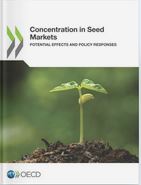 Topics Topics |
|
|
|
 Species Species |
|
|
|
|
|
U.S. winter wheat seeded area reflects supply, prices
Washington, DC, USA
January 15, 2015
Source: U.S. Wheat Associates
By Casey Chumrau, USW Market Analyst
USDA released a trio of reports this week showing how farmers reacted to weather conditions, relatively high U.S. wheat supplies and relatively low farm gate prices last fall when they seeded winter wheat. Planted area for hard red winter (HRW) and soft red winter (SRW) is down while soft white (SW) winter seedings increased following a shorter Pacific Northwest crop in 2013/14.
USDA’s quarterly Grain Stocks report revealed lower than expected 2014/15 U.S. consumption, which appeared as increased U.S. carry-out stocks in USDA’s monthly World Agricultural Supply and Demand Estimates report (WASDE). Next, the agency’s annual Winter Wheat Seedings report showed winter plantings for the 2015/16 U.S. harvest fell 5 percent from the previous year to 40.5 million acres (16.4 million hectares), including relative declines for two of the three winter wheat classes.
The Grain Stocks report showed 41.5 million metric tons (MMT) of wheat was in U.S. storage bins as of Dec. 1, 2014, up 3 percent from the prior year. Following a recent trend, increased on-farm storage indicates that farmers who have the option are holding their wheat for higher prices. On-farm stocks of 12.9 MMT are up 28 percent from a year ago. The report also revealed lower domestic disappearance than analysts had expected for September to November.
The WASDE report reflected the lower domestic consumption by reducing total projected 2014/15 wheat use by 89,000 metric tons to 32.2 MMT. As a result, the U.S. carry-out stocks estimate increased by the same margin to 18.7 MMT. If realized, carry-out stocks would be 16 percent greater than 2013/14 but still below the five-year average of 21.2 MMT.
The Winter Wheat Seedings report is the first official glimpse at the 2015/16 U.S. wheat crop potential. Estimated acreage was lower than last year and below analyst expectations. At an estimated 29.5 million acres, HRW seedings would be 3 percent lower than last year but slightly more than the five-year average of 29.3 million acres. USDA reports wheat acres dropped significantly in five of the top seven HRW producing states. Seedings in Colorado, Kansas, Montana, Oklahoma and Texas collectively fell 950,000 acres, a 4 percent drop from 2014/15. A combined increase year over year in Nebraska and South Dakota helped offset the decline. According to USDA estimates, HRW acres accounted for 73 percent of total winter wheat acres planted for the 2015/16 crop.
Unfavorable conditions at planting time may have contributed to the drop in Kansas and other states. Kansas Wheat CEO Justin Gilpin told the Associated Press that cold weather and dry soils in the late fall kept some farmers from planting more wheat.
SRW wheat seeded area decreased an estimated 12 percent to 7.50 million acres with acreage dropping in nearly every SRW state. If realized, it would be 6 percent below the five-year average and the fewest SRW acres planted since 2010/11. USDA estimates seedings in Illinois and Missouri fell a combined 26 percent, down 420,000 acres from last year.
Following a drought that cut SW yields in the Pacific Northwest states of Washington and Oregon, farmers there seeded 3 percent more acres of SW winter wheat compared to 2013/14. In Washington, the top white wheat producing state, acreage increased an estimated 100,000 acres to 1.8 million. In Oregon, a 30,000-acre increase offset a decrease in Idaho of the same number. USDA estimates total white winter wheat seeded area at nearly 3.48 million acres, up 2 percent from last year.
Regarding global wheat trade, USDA estimates that exportable supplies from Russia will decline by 2 MMT for 2014/15 (through May 2015) as a result of the government’s decision to impose export duties effective Feb. 1, 2015 (see article below). USDA’s January forecast for 2014/15 U.S. wheat exports was unchanged at 25.2 MMT.
More news from: U.S. Wheat Associates
Website: http://www.uswheat.org Published: January 15, 2015 |
|
|
|
Better Food Venture's
AgTech Landscape 2019

|
| |
|
2019 THRIVE Top 50
landscape map

|
| |
|
Concentration in Seed Markets - Potential Effects and Policy Responses

(OECD December 2018)
|
|
Visualizing Consolidation
in the Global Seed Industry
1996–2018

Seed Industry Structure
1996-2018
Phil Howard
Associate Professor
Michigan State University
|
|
2017 Seed Company Family Tree
Ccreated Septebmer 2017
by Robert Walsh
WaSoo Farm, Elk Point, South Dakota |
 |
Syngenta Brands Family Tree
Ccreated January 2017 by Robert Walsh, WaSoo Farm, Elk Point, South Dakota
|
 |
| |
Rabobank's
World Vegetable Map 2018 |
 |
|
|